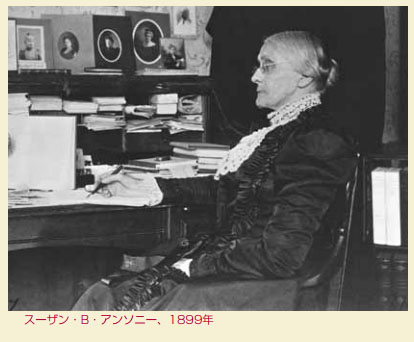国務省出版物
女性実力者の系譜-女性投票権 「スーザン・ブラウネル・アンソニー」
 女権運動の「比類なきまとめ役」 1820年2月15日生まれ、1906年3月13日死去
女権運動の「比類なきまとめ役」 1820年2月15日生まれ、1906年3月13日死去
エリザベス・キャディ・スタントンと同じく、スーザン・B・アンソニーも北東部出身で、意志強固な父親の指導の下で人生を歩みだした。マサチューセッツ州アダムズ生まれのアンソニーは、ビジネスマンとして成功したクエーカー教徒の奴隷制度廃止論者の家庭で育った。伝えられるところによると、彼女は3歳で読み書きができたそうで、英才児として知られていた。
アンソニーは20代半ばに教師になり、最終的には地元の学校の校長としてニューヨーク州ロチェスター地区に落ち着いた。そして、飲酒を社会と家庭の不幸の根源とみなし、「酒瓶」に反対する政治的・宗教的運動である禁酒運動に引き込まれていった。男性が支配する組織では過小評価され、発言できないと感じたアンソニーと一部の友人たちは、「ニューヨーク州女性禁酒協会」を設立した。1850年頃、アンソニーはエリザベス・キャディ・スタントンと出会い、彼女に従って女性の権利を求めるより大規模な活動を行うようになった。
スタントンと違い、アンソニーは一度も結婚せず、自分の時間とエネルギーのすべてを政治活動に費やした。1856年から1861年の南北戦争の勃発まで、「米国奴隷制度廃止協会」の一員として働き、戦争中も奴隷解放のために引き続き尽力した。その後アンソニーは、スタントンとともに女権の請願活動に従事し、進歩主義的雑誌である「ザ・レボリューション」を創刊し、「ニューヨーク勤労女性協会」の設立を助けた。1870年に合衆国憲法修正第15条が採択され、「人種、肌の色または過去における労役の状態」に関わらず、すべての市民に投票する権利が保障されたが、この中に「性別にかかわらず―」と言う言葉は含まれなかった。この状況に唖然としたアンソニーは直接的な行動に立ち上がり、女性の一群を率いてロチェスターの投票所に向かった。
逮捕され、裁判を待つ間に、彼女は世間の注目を利用して講演旅行を始めた。1873年、彼女は再び市民的不服従運動を行い、またも投票を試みた。彼女は女性であることを理由に自分の裁判で証言する権利を拒絶され、軽い罰金を科せられたが、その支払いを拒否した。この戦いと、それに伴う世間の注目に鼓舞されて、彼女は米国人女性の投票権を実現するために、全国規模の組織を通じて、また東部諸州や西部の準州での個人的な講演旅行によって、これまで以上に活発に活動した。
アンソニーは1888年に「国際女性会議」、1904年には「国際女性参政権同盟」を設立して、ロンドンとベルリンで会合を開き、その活動を国際的レベルに押し上げた。彼女はスタントンの死から4年後の1906年に亡くなったが、彼女たちの仕事が道を開き、米国人女性に投票権を認めた、合衆国憲法修正第19条が1920年に承認されるに至った。
*上記の日本語文書は参考のための仮翻訳で、正文は英文です。
Susan Brownell Anthony
“Incomparable Organizer" of women's rights movement"
Like Elizabeth Cady Stanton, Susan B. Anthony came from the Northeast, and began her life under the tutelage of a strong-willed father. Born in Adams, Massachusetts, Anthony grew up in the home of a successful businessman, Quaker, and abolitionist. She was known as a gifted child, reportedly able to read and write at the age of three.
In her mid-20s Anthony began a teaching career, eventually settling in the Rochester, New York, area as the headmistress of a local school. She was drawn towards the "temperance" movement, a political and religious movement that viewed alcohol consumption as the root of social and familial ills, and campaigned against the "bottle." Feeling marginalized and unable to speak in a male-dominated organization, Anthony and some friends founded the Woman's State Temperance Society of New York. Around 1850 she met Elizabeth Cady Stanton, and joined her in the larger crusade for women's rights.
Unlike Stanton, Anthony never married, and put all her time and energy into political organizing. Anthony worked as a member of the American Anti-Slavery Society from 1856 until the outbreak of the U.S. Civil War in 1861 and continued to work for slaves' emancipation during the war. With Stanton, she engaged in petition drives for women's rights, founded a progressive magazine, The Revolution, and helped organize the New York Working Women's Association. With the adoption in 1870 of the 15th Amendment, all citizens were guaranteed the right to vote regardless of "race, color, or previous condition of servitude," but not regardless of gender. Appalled at this situation, Anthony took direct action, leading a group of women to the polls in Rochester. Arrested and awaiting trial, she took advantage of the publicity to begin a lecture tour. In 1873, she again engaged in civil disobedience, again trying to vote. She was denied the right to testify at her own trial because of her sex, and given a light fine, which she refused to pay. Spurred on by the fight and the attendant publicity, she worked more vigorously than ever to secure American women the right to vote – through national organizations and individual lecture tours in eastern states and western territories.
In 1888, Anthony organized the International Council of Women and in 1904 the International Woman Suffrage Alliance, bringing her crusade to the international level with meetings in London and Berlin. She died in 1906 – four years after Stanton – but their work paved the way for the ratification of the 19th Amendment to the U.S. Constitution, which, in 1920, granted American women the right to vote.
In print: The History of Woman Suffrage, edited by Susan B. Anthony, Elizabeth Cady Stanton, Matilda Joslyn Gage, and Ida Husted Harper




